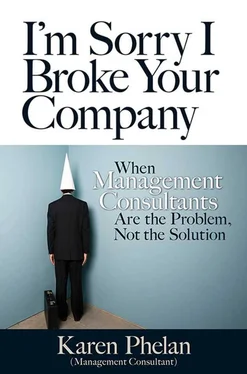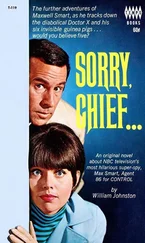Karen Phelan - I'm Sorry I broke Your Company
Здесь есть возможность читать онлайн «Karen Phelan - I'm Sorry I broke Your Company» весь текст электронной книги совершенно бесплатно (целиком полную версию без сокращений). В некоторых случаях можно слушать аудио, скачать через торрент в формате fb2 и присутствует краткое содержание. Город: San Francisco, Год выпуска: 2013, ISBN: 2013, Издательство: Berrett-Koehler Publishers, Жанр: management, popular_business, на английском языке. Описание произведения, (предисловие) а так же отзывы посетителей доступны на портале библиотеки ЛибКат.
- Название:I'm Sorry I broke Your Company
- Автор:
- Издательство:Berrett-Koehler Publishers
- Жанр:
- Год:2013
- Город:San Francisco
- ISBN:978-1-60994-740-8; 978-1-60994-741-5
- Рейтинг книги:3 / 5. Голосов: 1
-
Избранное:Добавить в избранное
- Отзывы:
-
Ваша оценка:
- 60
- 1
- 2
- 3
- 4
- 5
I'm Sorry I broke Your Company: краткое содержание, описание и аннотация
Предлагаем к чтению аннотацию, описание, краткое содержание или предисловие (зависит от того, что написал сам автор книги «I'm Sorry I broke Your Company»). Если вы не нашли необходимую информацию о книге — напишите в комментариях, мы постараемся отыскать её.
I'm Sorry I broke Your Company — читать онлайн бесплатно полную книгу (весь текст) целиком
Ниже представлен текст книги, разбитый по страницам. Система сохранения места последней прочитанной страницы, позволяет с удобством читать онлайн бесплатно книгу «I'm Sorry I broke Your Company», без необходимости каждый раз заново искать на чём Вы остановились. Поставьте закладку, и сможете в любой момент перейти на страницу, на которой закончили чтение.
Интервал:
Закладка:
The term «consultant» is used very loosely. Anyone who is a contractor to a business is considered a consultant. Plus, there are all sorts of technology consultants, marketing consultants, and design consultants. When I use the term «management consultant,» I am talking about those who work with the top layers of corporate management and advise them on what to do. More specifically, my ire is mostly addressed at the large consultancies that hire MBAs straight out of school and arm them with spreadsheets, pro forma methodologies, incoherent jargon, and a not-small amount of arrogance. I blame these people for conceiving and propagating the many management myths that are the roots of some of the biggest problems in business today — lack of innovation, short-term focus, obsession with financial gains over creating valuable products and services, and stressed-out, overworked, and disengaged employees.
Rather than focusing on the obvious question — How can my business make life better? — corporate leaders have spent the last few decades fixating on other, less-meaningful questions like,
• How do I gain a competitive advantage?
• How do I maximize my shareholder value?
• How do I increase my bottom line (both personal and corporate)?
• How do I optimize the efficiency of my human assets?
The result is lean and mean companies that operate alike, offer copycat products and services, and are dependent on acquisitions for growth. Many of these problems are rooted in the accepted management wisdom that abounds with little proof of veracity. The beginnings of all this management dogma started with one or more management consultants. The best analogy I can use to explain this cycle is diet and exercise fads. It seems like every year brings a doctor or fitness expert who has found the solution for weight loss. That solution may be a miracle food or a rigorous diet program or a new exercise regimen. However, none of these fads work, and worse, they often result in yo-yo dieting that leads to more weight gain and overall poor health. To be healthy, you need to eat a variety of foods in moderation and get plenty of exercise and enough sleep. The secret to weight loss is the same secret that everyone has known forever. There is no secret.
Similarly, every year, management consultants develop some new model or theory that will be the answer to all your business problems. Visit the website of any consultancy and you will see that it sells «business solutions.» Management consultants strive to achieve thought leadership by creating new models and theories that hopefully will be adopted widely by businesses and make them famous (and rich). However, all this has just led us to fad after fad after fad. The widespread adoption of each fad brings with it its own set of problems that lays the groundwork for the next fad. Competitive strategy based on external factors led to competence strategy based on internal capabilities, which led to blue ocean strategy based on top-down ideation, which led to adaptive strategy based on bottom-up responses to the marketplace. Each one corrects the deficiencies of the former fad but then creates deficiencies of its own. The result is a vicious cycle similar to dieting, gaining weight, more dieting, and more weight gain. The only way to stop the fads is to stop the management consultants creating and selling them.
About this book
This is not an academic book offering original research or proof positive of my ideas. This is the story of how I came to realize that everything I believed about business was wrong. It's my story woven with the rise and fall of some of the management fads I helped propagate. I chose the examples based on how they changed my thinking about what I was doing. The first three chapters recount my experiences with strategy development, process improvements, and metrics implementations. Many of the examples in these chapters are from my early career as a young consultant, when I worked for large consultancies. The next four chapters discuss the methods that fall under the banner of «talent management» and cover performance management systems, management models, high-potential programs, and leadership competencies. Most of the examples in these chapters relate to my experiences in a later part of my career in the corporate world, where I got to live through many of the methods I had helped implement.
I would like to be very clear about my purpose. The point of this book is to debunk the conventional business wisdom and not to add to it. Although I offer my recommendations, I offer them as alternatives to the theories that don t work. For the most part, I recommend replacing the model or process with a candid conversation among colleagues. Unfortunately, I haven’t done a major study to show that improving dialogue and relationships has a business benefit. I will let you be the judge of that theory. Fortunately, debunking a theory is much easier. It requires only one piece of evidence that disproves it. I’m going to repeat this because most consultants I know have a hard time understanding this: you need only one piece of contrary evidence to disprove a theory. Proving a theory to be true is much harder, requiring that it works in all situations. This is where management consultants often get it wrong. They find something that works once or twice and label it a best practice to be followed by everyone when it is useful only in a specific situation.
I offer recommendations and alternatives as a starting point to help us get out of the faulty thinking that pervades today, like «You can’t manage what you can’t measure.» (Well, yes you can!) I am in no way suggesting that I have the solutions. I’m just suggesting that instead of implementing a method that is often wrong, we try doing something else that might work. I’m suggesting that we cut through the dogma to find the kernel of truth and base our new solutions on that truth. Isn’t it better to have only a chance of being wrong than to most certainly be wrong? I think that’s pretty obvious. In fact, if I were to describe what this book is about, I think it’s about the really obvious.
1
Strategic Planning Can't Predict the Future
Strategy Development Is a Vision Quest
In 1980, Michael Porter, a Harvard professor and founder of the Monitor Group consulting company, published a book called Competitive Strategy: Techniques for Analyzing Industries and Competitors and helped usher in the modern age of business strategy consultants that exploded in the ’80s and ’90s. While boutique consultancies, namely Bain and the Boston Consulting Group, were formed in the ’60s, either their client base was limited or their models dealt with managing cash. Actually formulating a business strategy was something of a black art consisting of one part analysis, one part experience, and a whole lot of magic — kind of like a corporate version of the Native American drug-induced rite of self-discovery, the vision quest. However, businesses tend to prefer analysis, structure, and tangibility over magic, art, and lucid dreaming. Michael Porters book not only codified how to create a strategy, with step-by-step instructions on how to do the analysis, it also codified what the strategies should be.
Besides embedding the phrase «competitive advantage» into the corporate psyche, Porter introduced two well-known models in his book. The first was the five-forces model, which showed the external and internal factors facing businesses: competitors, potential entrants, potential substitutes, buyers, and suppliers. This was the framework for performing the industry analysis and was introduced in chapter 1. The second chapter offered up Porters second most famous item: the three generic business strategies of lost-cost producer, differentiation, and focused offering. Depending on your position in the industry, you would choose one of the three strategies to gain a competitive advantage. The rest of the book is an incredibly comprehensive blueprint for analyzing competitors, anticipating their potential responses, and dissecting industry structures to determine alternative strategies — all with a multitude of checklists to use. After several attempts at reading this book and eventually struggling through it, I came to realize that perhaps the reason why the five-forces model and the generic strategies were the only models to become part of the management lexicon was that few people were able to read beyond the first two chapters. With Porters models and checklists, consultants had both a method and a set of answers that could be packaged and implemented by any reasonably smart college graduate. The art part of strategy formulation was replaced by a series of checklists and a multiple-choice option and made available to anyone.
Читать дальшеИнтервал:
Закладка:
Похожие книги на «I'm Sorry I broke Your Company»
Представляем Вашему вниманию похожие книги на «I'm Sorry I broke Your Company» списком для выбора. Мы отобрали схожую по названию и смыслу литературу в надежде предоставить читателям больше вариантов отыскать новые, интересные, ещё непрочитанные произведения.
Обсуждение, отзывы о книге «I'm Sorry I broke Your Company» и просто собственные мнения читателей. Оставьте ваши комментарии, напишите, что Вы думаете о произведении, его смысле или главных героях. Укажите что конкретно понравилось, а что нет, и почему Вы так считаете.












